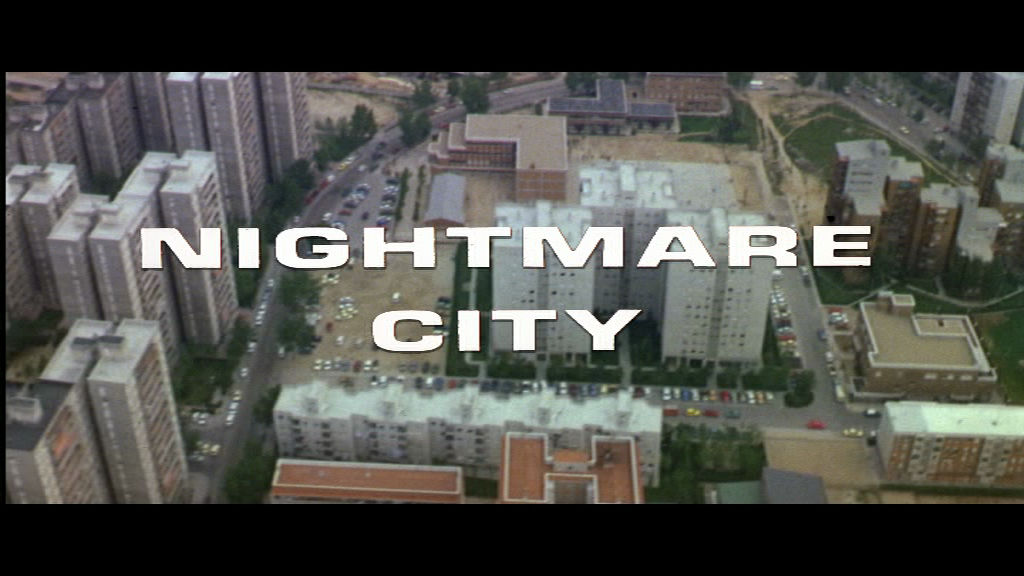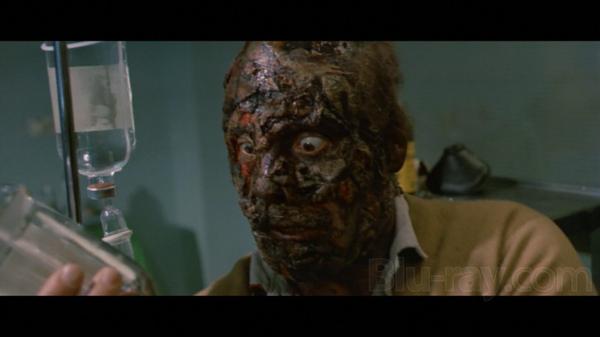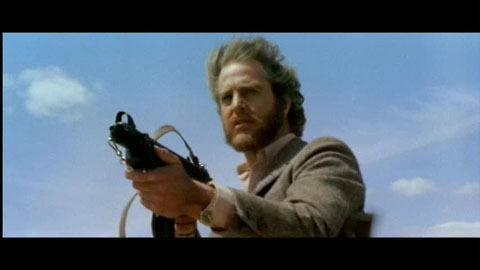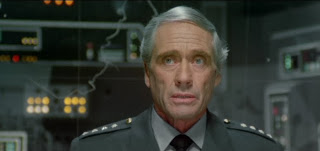Remembering Umberto Lenzi’s Nightmare City
As with his (more popular) contemporary Lucio Fulci, the reputation in horror circles of Italian director Umberto Lenzi hinges entirely on a small cluster of graphically gory movies he made very close together in the early 80’s while well into middle-age. Like Fulci, Lenzi’s notoriety in the UK was enhanced by his presence on the Video Nasties list, though he was also notable for both making the movie (THE MAN FROM DEEP RIVER) that established the cannibal cycle, and for returning to the sub-genre to cash-in on the success of Ruggero Deodato’s CANNIBAL HOLOCAUST with the memorable CANNIBAL FEROX.
Although his most discussed films tend to be the trio that emerged in 1980/1 (FEROX, NIGHTMARE CITY and EATEN ALIVE), Lenzi had already established himself in the 70’s as a proficient and versatile director of significant giallo (SPASMO, SEVEN BLOODSTAINED ORCHIDS, EYEBALL) and particularly tough, fast-paced action-thrillers (VIOLENT NAPLES, ALMOST HUMAN) capitalising on the vogue for rough-edged urban cop movies in the early 70’s. The opening of FEROX, in fact, opens like one of Lenzi’s hard-edged policiers with gangland activity on the streets of New York City before the action shifts to the Amazon so that coke-head misogynist John Morghen can get his knob sliced off.
NIGHTMARE CITY lacks the hard-edged intensity of Lenzi’s cop movies or the lingering sadistic violence of his cannibal movies, and as such did not trouble the Nasties list in the UK; nor did it face any problems when submitted for a certificate by Anchor Bay in the early years of DVD, emerging unscathed with its BBFC 18 in 2003. Its lively array of mastectomies, dismemberments and exploding heads were, however, emasculated in the post-nasties era, thanks to a 1986 Stablecane VHS release shorn of just over three minutes of gore. Arrow’s 2015 blu-ray release of the movie, offering two different versions of the film thanks to a nightmarish pursuit of the best possible materials for high-def mastering, looks set to be the definitive presentation of the movie, at least for now.
Whatever You Do, Don’t Call Them “Zombies”….
Lenzi has made it clear that, prior to NIGHTMARE CITY, he had not seen the Romero zombie movies responsible for triggering the hugely successful Fulci cash-in we know and love as ZOMBIE FLESH EATERS. In some interviews, he has underplayed the fact that he ever made “horror films” at all, while persistently reiterating that NIGHTMARE CITY is not a zombie movie and that it was his idea to make a film about “contaminated” people. Lenzi has regularly, quite credibly accused 28 DAYS LATER, with its brisk “Rage” victims, of ripping off his disarmingly effective variation on the rampaging-zombie concept two decades later. (He also believes Zack Snyder’s take on DAWN OF THE DEAD stole the fleet-footed nature of his “contaminated” hordes for its zombies, though the more likely case is that Snyder was merely echoing the successful 28 DAYS LATER).
The movie was inarguably conceived as another splattery Italian horror flick to ride the coattails of the Fulci success, though Lenzi’s own mission to offer a more socially conscious alternative to regular zombies ensured the film ended up as one of the more unique entries in the early 80’s gore stakes. Released in the US under the notably meaningless title CITY OF THE WALKING DEAD (note: they’re not dead, and they are more prone to running than walking), the movie has enjoyed a strong afterlife and its famous geek fans include Quentin Tarantino and Eli Roth. In contrast to the ambience-driven, more leisurely paced approach adopted by Fulci for ZOMBIE FLESH EATERS, NIGHTMARE CITY is distinguished by Lenzi’s trademark no-fuss, action-driven attitude to a sub-genre usually defined by meandering dialogue sequences punctuated by eyeball gougings.
City Of The Running Infected
As with many of its contemporaries, the film’s high definition release in the 21st century not only serves to highlight the cheesy make-up and mutilations on display but is also awash with a huge nostalgia factor built upon the “They don’t make ‘em like this anymore!” lament of long-term gore fans. Lenzi was undeniably ahead of the game in his decision to replace the lumbering, decayed denizens of the undead beloved of Romero and Fulci pictures with fast-moving, intelligent, blood-drinking infection-victims assaulting their victims with whatever weapons happen to be in easy reach. For that reason and for the film’s unusually ambitious scale (multiple locations, a war movie bodycount, countless extras), NIGHTMARE CITY looks and feels very different to its contemporaries while sharing their considerable retro charms.
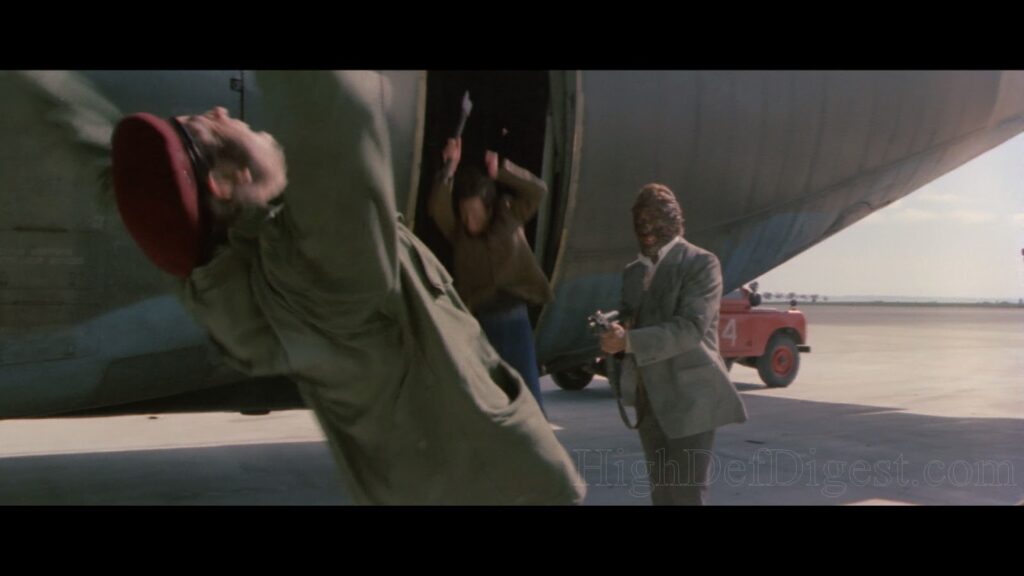
The plot riffs more on Romero’s THE CRAZIES than it does NIGHT OF THE LIVING DEAD, and
the root cause of the infection suggests Lenzi was inspired by the then-recent THE CHINA SYNDROME and the real life calamity from which it was born. A radioactive spill at a state nuclear power plant – conveyed mostly via news reports, as in the Romero films – has a devastating effect on the population, transforming them into mutated, excessively aggressive hordes that attacking indiscriminately. Our hero is the slightly odd, beardy Hugo Stiglitz, who gets wind of what’s going on when his proposed interview with a Nuclear scientist is abandoned due to an early, bravura airport massacre. These “zombies” drive, fly planes, kill people with knives / axes / machetes and, with the exception of a few sporting dodgy facial make-up, largely look like ordinary folk having a bad day. Early on, a televised aerobics session is interrupted by the infected (“Oh shit, just when I was going to do my first close-up!”) and ultra-violence also hits a hospital at which Stiglitz’s philosophising wife (Laura Trotter) works, a church and, climactically, a fun fair. Yep, years before smarmy high-concept horror-comic movies became the rage, prepare yourselves for Zombies* On A Rollercoaster. (*They’re not really zombies, you know).
It Was 1980…
Also joining in the fun are a stern major and his young sculptor girlfriend (“I’m not Michelangelo!” – no kidding!!), plus American import Mel Ferrer, a fixture of Lenzi’s EATEN ALIVE, in the Basil Exposition role. Hapless victims have a tendency to say stupid things to the infected before perishing, like “Hey, what are you doin’ with that gun?!”, while the female cast members are normally duty bound to expose their breasts before being mutilated. Well, it was 1980.
Female lead Trotter represents the personification of the script’s attempt at sub-Romero profundity, given to remarking “It’s part of the vital cycle of the human race…create and obliterate until we destroy ourselves” while pompously discussing how much healthier we’d be without modern luxuries like Coca-Cola and nuclear energy. (CANNIBAL FEROX similarly pauses so that characters can mull over the situation with simplistic observations like “It’s us, the so-called civilised people who are responsible for their cruelty! Violence breeds violence!”). Having been so collected and thoughtful throughout, however, Trotter becomes a ranting hysteric when the going gets rough. Well, it was 1980 (still).
Lenzi steers clear of the lingering sadism beloved of Fulci, instead favouring lots of frenetic, fleetingly bloody action set pieces in which heads explode, eyes are removed and boobies are cut off in a zippy, inoffensive fashion. The sheer scale impresses given the typical low budgets bestowed upon these movies, and it’s so much gleeful fun that you even end up forgiving the ridiculous cop-out “twist” which, in this spoiler-fearing era, we can only refer to as the “Bobby In Dallas” Ending. Man-Of-The-Match Stelvio Cipriani’s pounding, infectious Goblin-inspired, prog rock-infused music score, will invade your brain after about five seconds and refuse to leave.
Lenzi’s Legacy
Due to the rapid rise and fall of the Italian splatter movie in the early 80’s, Lenzi’s reign in the field seemed over almost as soon as it began: his genre output following EATEN ALIVE was sparse until the late 80’s, when it consisted of mediocre TV movies and mostly well-behaved diversions like GHOST HOUSE. NIGHTMARE BEACH belatedly but enthusiastically runs through the clichés of the earlier American slasher cycle, throwing in wet t-shirt contests, John Saxon as a stern Sheriff, a peeping tom red herring and a puritanical, guessable mystery killer ranting about heathen teenagers. HITCHER IN THE DARK is perhaps the strongest meat from Lenzi’s tame late 80’s genre entries, drenched in seediness as it focuses on an impotent Norman Bates-ish mommy’s boy’s fixation on a comely Josie Bissett and veers into sadistic territory for a LAST HOUSE ON THE LEFT-style interlude of the central psycho carving the word “pig” into the chest of a minor character.
Lenzi certainly made stronger movies than NIGHTMARE CITY and he undoubtedly made more shocking movies, but it’s hard to find one that rates so high on the good old-fashioned “fun” scale. It lingers in the memory with a glow fonder than most, which presumably explains the upcoming, partially crowd-funded Tom Savini-directed remake that will be needlessly coming our way next year.
Article written by Steven West

